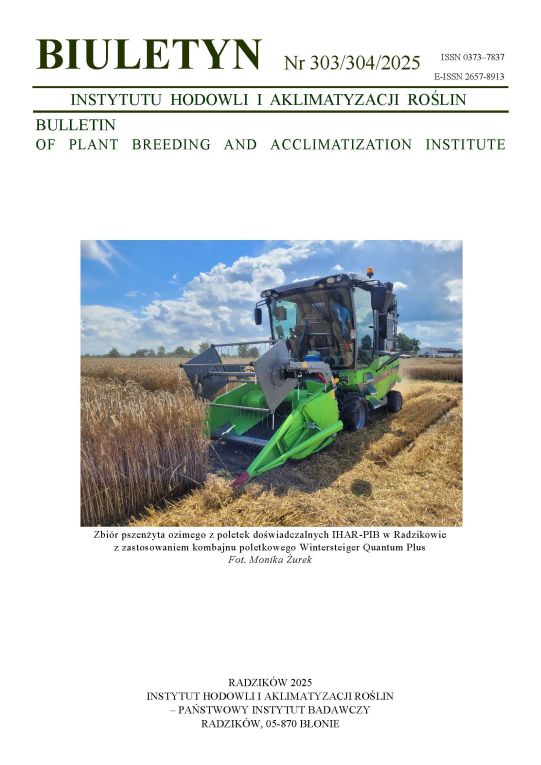Residual effects of irrigation, haulm destruction and nitrogen fertilization on yielding potential of seed-potatoes
Tomasz Maciejewski
agro@up.poznan.plKatedra Uprawy Roli i Roślin, Akademia Rolnicza im. Augusta Cieszkowskiego w Poznaniu (Poland)
Jerzy Szukała
Katedra Uprawy Roli i Roślin, Akademia Rolnicza im. Augusta Cieszkowskiego w Poznaniu (Poland)
Stanisław Grześ
Katedra Uprawy Roli i Roślin, Akademia Rolnicza im. Augusta Cieszkowskiego w Poznaniu (Poland)
Abstract
The importance of residual effects of irrigation, haulm destruction and nitrogen fertilization for yielding of a very early potato cultivar Aster was evaluated in a 3-year experiment carried out at the Experimental Station Gorzyń. Seed-potatoes for the studies originated from the experiments conducted in 1998–2000 at the Experimental Station Złotniki. The residual effect of irrigation on potato yielding potential, assessed by analyses of tuber yield, starch yield and starch content, was found to depend on weather conditions in the vegetation period. No direct effect of haulm destruction on tuber yield and starch content was recorded. The most considerable yielding potential was exhibited by the potatoes grown in the plots fertilized with nitrogen dose of 40 kg/ha.
Keywords:
haulm destruction, irrigation, nitrogen fertilization, seed-potatoesReferences
Bielińska-Czarnecka M., Białek K. 1972. Activity of growth inhibitors in potato tubers during the vegetation and storage. Bull. Acad. Polon. Sci. Ser. C. Biol. 20: 809 — 812.
Google Scholar
Bodlaender K. B. A., Marinus J. 1987. Effect of physiological age on growth of seed potatoes of two cultivars. 3. Effect on plant growth under controlled conditions. Potato Research 30: 423 — 440.
Google Scholar
Borówczak F. 1997. Effects of sprinkling irrigation of seeds crops in Poland. In: Proceedings of Poland — Israel Conference on water requirements and irrigation effects of plants cultivated in arid and semiarid climates. Tel-Aviv: 149 — 155.
Google Scholar
Gabriel W. 1977. Wartość nasienna sadzeniaka. W: Hodowla i nasiennictwo ziemniaka. W. Gabriel, K. Świeżyński, PWRiL Warszawa: 238 — 243.
Google Scholar
Reust W. 1986. EAPR working group “Physiological age of the potato”. Potato Research 29: 267 — 271.
Google Scholar
Reust W. 1990. Sur l’importance des caractéres physiologiques des variétiés de pomme de terre, la conservartion de plants, la prégermination et le rendement. revue Suisse Agriculture 22: 51 — 57.
Google Scholar
Rykaczewska K. 1993. Wiek fizjologiczny bulw matecznych ziemniaka jako czynnik modyfikujący produktywność roślin. Frag. Agron. 2: 5 — 50.
Google Scholar
Rykaczewska K. 1999. Wpływ wieku fizjologicznego bulw matecznych i usuwania kiełków przed sadzeniem na rozwój roślin i plon wczesnych odmian ziemniaka. Biul. IHAR 209: 97 — 110.
Google Scholar
Sobiech S. 2000. Ziemniak. W: Nasiennictwo. Rozmnażanie materiału siewnego. K. W. Duczmal, H. Tucholska, PWRiL Poznań: 79 — 95,
Google Scholar
Zaag van der D. E., van Loon C. D. 1987. Effect of physiological age on growth vigour of seed potatoes of two cultivars. 5. Review of literature and integration of some experimental results, Potato Research 30: 451 — 472.
Google Scholar
Authors
Tomasz Maciejewskiagro@up.poznan.pl
Katedra Uprawy Roli i Roślin, Akademia Rolnicza im. Augusta Cieszkowskiego w Poznaniu Poland
Authors
Jerzy SzukałaKatedra Uprawy Roli i Roślin, Akademia Rolnicza im. Augusta Cieszkowskiego w Poznaniu Poland
Authors
Stanisław GrześKatedra Uprawy Roli i Roślin, Akademia Rolnicza im. Augusta Cieszkowskiego w Poznaniu Poland
Statistics
Abstract views: 70PDF downloads: 81
License
Copyright (c) 2007 Tomasz Maciejewski, Jerzy Szukała, Stanisław Grześ

This work is licensed under a Creative Commons Attribution-ShareAlike 4.0 International License.
Upon submitting the article, the Authors grant the Publisher a non-exclusive and free license to use the article for an indefinite period of time throughout the world in the following fields of use:
- Production and reproduction of copies of the article using a specific technique, including printing and digital technology.
- Placing on the market, lending or renting the original or copies of the article.
- Public performance, exhibition, display, reproduction, broadcasting and re-broadcasting, as well as making the article publicly available in such a way that everyone can access it at a place and time of their choice.
- Including the article in a collective work.
- Uploading an article in electronic form to electronic platforms or otherwise introducing an article in electronic form to the Internet or other network.
- Dissemination of the article in electronic form on the Internet or other network, in collective work as well as independently.
- Making the article available in an electronic version in such a way that everyone can access it at a place and time of their choice, in particular via the Internet.
Authors by sending a request for publication:
- They consent to the publication of the article in the journal,
- They agree to give the publication a DOI (Digital Object Identifier),
- They undertake to comply with the publishing house's code of ethics in accordance with the guidelines of the Committee on Publication Ethics (COPE), (http://ihar.edu.pl/biblioteka_i_wydawnictwa.php),
- They consent to the articles being made available in electronic form under the CC BY-SA 4.0 license, in open access,
- They agree to send article metadata to commercial and non-commercial journal indexing databases.
Most read articles by the same author(s)
- Franciszek Borówczak, Stanisław Grześ, Influence of irrigation, foliar fertilization and nitrogen application on the yields and economic effects of sugar beet cultivation for seeds , Bulletin of Plant Breeding and Acclimatization Institute: No. 222 (2002): Regular Issue
- Franciszek Borówczak, Stanisław Grześ, Influence of irrigation, foliar fertilization and nitrogen application on root yields and on economic effects of sugar beet cultivation , Bulletin of Plant Breeding and Acclimatization Institute: No. 222 (2002): Regular Issue














